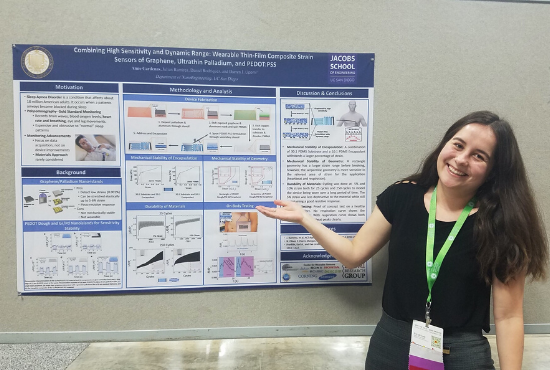Anne Cardenas

Hi, I'm Anne
I am a UR NACME Scholar and a Revelle College student, majoring in Nanoengineering. My pronouns are she/her/hers.
Summary of Research
My research path has been extensive and varied within the area of Nanoengineering and nanomaterials. The summer between my community college graduation and transferring to University of California, San Diego I conducted research at Rutgers University in New Jersey as part of the Research-Intensive Summer Experience (RISE, formerly Research in Science and Engineering). My research project on metallic MoS2 nanosheets, a 2-Dimensional nanomaterial similar to graphene, consisted of exploring its energy storage applications, specifically, its capabilities as a supercapacitor. This was my first research experience and it opened my eyes to what a career in research would look like. Although my time there was short, it taught me the basic laboratory skills that I’ve carried into my other experiences ever since.
During the school year, I conduct research at my home institution, University of California, San Diego. My work there has yielded me a co-authored publication in the field of mechanical sensors for wearable medical device applications in ACS Applied Nanomaterials. This project allowed me to be a part of the publication process for a peer-reviewed paper and it also allowed me to apply my skills as a Nanoengineer to a real-life problem. Based on my work on this project, I presented a poster at the 2019 SACNAS conference. I received first place in the category of Materials Research.
In addition to my research experience in academic institutions, I have also had experience conducting research in an industry setting. Over the past two summers, I have been working as an intern for Lawrence Livermore National Laboratory (LLNL). This experience introduced me to two more areas of NanoEngineering, piezoelectric materials and core-shell nanoparticle synthesis, bringing both of these fields together to develop a self-powered flexible display. Given my experience in the wearable, and therefore flexible, devices, I was also tasked with building prototypes. Compared to both of my experiences in academia where I either worked alone or with a small team, my time at LLNL exposed me to working with a large group of people, all with different areas of expertise and roles in the project. My work there has even led to a Record of Invention (ROI) filing and to a 1st place win at the Summer Intern Poster Symposium.
How did you get started in undergraduate research?
I was introduced to research by my mentor at the MESA program at San Diego City Community College. He was the one that encouraged me to apply to the RISE program at Rutgers University, which I completed during the Summer of 2017. Once I transferred to UCSD I got into doing research at the Lipomi Lab after the Nanoengineering department sent out a mass email announcing they had positions open during finals week of Fall 2017. I sent in my resume, interviewed and was ultimately hired for the position. Based on advice from my graduate student mentor in the Lipomi lab I applied to be part of the IMSD program on campus so that I could be paid for the research I do. I was introduced to Lawrence Livermore National Lab via a scholarship they host through the Jacobs School of Engineering. After being awarded the scholarship in Winter 2018, they reached out and invited me to apply to their internship program via the SULI program. I have been conducting research for them every summer since.
Why did you apply to the scholarship/grant?
I decided to apply to the NSF Graduate Research Fellowship Program (GRFP) so that I could continue my research into flexible electronics as part of a Materials Science and Engineering graduate program. I didn’t think I would get the fellowship as I am pursuing a master’s Thesis, not a PhD degree. I went in with the mind set of having the opportunity to practice my research proposal skills and was only expecting to get feedback on my work. Needless to say, I was very surprised when I received this award. I am very thankful for this as it will enable me to do my master’s degree without worrying about student loans or having a part-time job.
Future career plans or goals
I have decided to do my masters at UCLA to work with Professor Ximin He on additive manufacturing of flexible electronic devices. After graduation, I hope to go into industry and apply my skills and knowledge to developing technologies that will enable human space travel such as remote health care monitoring and automated crop growing. I believe developing these capabilities will not only push the boundaries of current space travel capabilities but will also help us develop technologies for life here on Earth such as in the health care and agricultural industries.
Related Links
- NSF Graduate Research Fellowship Program (GRFP) Official Website
- NSF Graduate Research Fellowship Program (GRFP) at UC San Diego
- Lipomi Lab
- IMSD Initiative for Maximizing Student Development
- SULI program
- NACME Scholar
Apply to a UR Program!
Are you interested in undergraduate research and/or scholarship opportunities like this one? Contact UR to learn more.